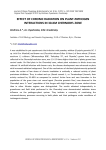Статьи журнала - Журнал стресс-физиологии и биохимии
Все статьи: 1004
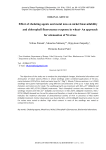
Статья научная
The objectives of the study are to analyze the physiological changes, biochemical alterations and attenuation of nickel toxicity effects in wheat seedlings under combined applications of Ni ions, metal chelators (EDTA/Citric Acid) and metal ions (Zn2+ /Mg2+). Wheat (Triticum aestivum L cv UP262) seedlings were grown hydroponically using different concentrations of Ni up to 7 days along with chelators and metal ions for study. The seedling growth was maximum with NiCl2-Zn2+ (100µM) and minimum with NiCl2-EDTA (100µM) treatments. Total chlorophyll content was maximum in the seedlings treated with NiCl2-Zn2+ (100µM) and minimum in NiCl2-EDTA (100µM) treatments. NiCl2-EDTA (100µM) showed less Fo and Fm values and therefore, a trend in the decrease in OJIP transient indicates the maximum alteration of photochemical activity of PS-II in presence of NiCl2-EDTA (100µM) treatment. Similar observation was found by NiCl2 -EDTA (200µM) treatment where Fo and Fm values were noted to decline. High nickel content in roots of the seedlings was noted as compared to shoots.
Бесплатно
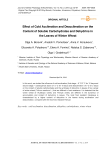
Статья научная
In this work, we studied the influence of cold acclimation (first stage - 8 °С/2 °С for 10 days and second stage - subsequence action of -2 °С for 10 days) and deacclimation (10 °С for 2 days) on the content of soluble carbohydrates and the synthesis of dehydrins in leaves of two variety of winter wheat ( Triticum aestivum L.) that are differed in frost resistance. It is detected that the winter wheat of Irkutskaya variety and Pamyat variety are differed in the dynamics of accumulation and content of dehydrins in leaves. The most frost resistant Irkutskaya is characterized by a higher content of dehydrins in the leaves during acclimation and deacclimation, compared with the less frost resistant Pamyat.
Бесплатно
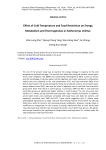
Статья научная
The aim of the present study was to examine the energy strategy in response to the cold temperature and food shortage. The survival rate, body mass, body fat content, serum leptin levels, basal metabolic rate (BMR) and nonshivering thermogenesis (NST) as well as masses and the morphology of visceral organs and the digestive tract were measured in Eothenomys miletus that was subjected to the cold temperature (5°C) and food restriction (80% of ad libitum food intake). The results showed that body mass, body fat content, serum leptin levels, brown adipose tissue (BAT) mass and dry mass of digestive tract in cold and food restriction group were lower than those in control group. In contrasts, BMR and NST in cold and food restriction group was significantly higher relative to control group. The rate of survival was 18.18% in E. miletus during cold and food restriction after 4 weeks acclimation. In addition, serum leptin levels were positively correlated with body mass and body fat content, and negatively correlated with BMR and NST. These results suggested that E. miletus apply physiological adjustments to adapt cold and food lacking external environment by reducing body mass, body fat content, and increasing energy metabolism. However, energy intake is insufficient to compensate for the increase in energy requirement due to cold, led to body mass decreased and mortality rate increased. Moreover, serum leptin may acts as a fat signals, and may be involved in the regulation of energy balance and body mass in E. miletus under the cold temperature and food restriction.
Бесплатно
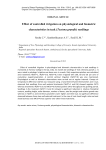
Статья научная
Effect of controlled irrigation in physiological and biometric characteristics in teak seedlings is monitored at Forestry College in Kerala, India. Six month old seedlings of Teak (Tectona grandis L. f.) were raised in polybags. Irrigation was done once in a week. Daily evapotranspiration was calculated and treatments IW/ET=1, IW/ET=0.6, IW/ET=0.3 were irrigated with 100, 60 and 30 per cent of cumulative evapotranspiration. A control without irrigation (IW/ET=0) was also maintained. Physiological as well as biometric observations were carried out at regular intervals. Canopy air temperature difference (CATD) was measured using a hand held infrared thermometer and it was observed that seedlings from well watered treatments (IW/ET=1 and 0.6) showed negative CATD whereas treatments IW/ET=0.3 and IW/ET=0 showed positive CATD throughout the growing period. Seedlings in the treatment IW/ET= 0 and 0.3 showed a significant reduction in relative chlorophyll content, seedling height, collar diameter, number of leaves, total dry weight and relative growth rate whereas in IW/ET=1 and 0.6 these parameters were higher and there was no significant difference observed between these two well watered treatment. In the case of root shoot length ratio and root shoot biomass ratio IW/ET=0 was superior over other three treatments.
Бесплатно
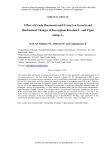
Статья научная
The present study was aimed to examine the influence of BRs on seed germination and seedling growth in Gossypium hirsutumL. Var Svpr 2 Vigna mungo (L.) Hepper Var T9. application of BRs on seed germination of Gossypium hirsutum the rate of germination considerably with varied percentage from 60.4 to 99. Vigna mungoseed also showed the varied percentage of germination from 56.8 to 80.1. Both the plants exhibited high percentage of vegetative growth such as shoot length, fresh weight, dry weight and leaf area on 3% of BR supplementation. The amount of chlorophyll a, b and total chlorophyll increased under BR treatments. Among the concentration, 3% BRs caused maximum effect than the other tested concentrations. High percentage of starch 53% and 31 % was observed in Gossypiumand Vignamungorespectively. The results of the present study shows that 3% BRs promotes the growth rate of Gossypium hirsutumL. Var Svpr 2 and Vigna mungo (L.) Hepper Var. T9. The results of the present study supplemented to the previous observations and practical utilization of the new steroidal group of phytohormones for large scale production of the economically important crops Gossypium hirsutumL. Var Svpr 2 and Vigna mungo (L.) Hepper Var. T9.
Бесплатно
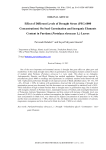
Статья научная
One of the most important environmental stresses is drought that great effect on plant grow and metabolism. In this study, drought stress effect on germination and inorganic elements content in leaves of medical plant Purslane (Portulaca oleraceae L.) were study. This plant as an Antiseptic, Antispasmodic, Diuretic, and Blood Filtering has medical application. Drought stress imposed by polyethylene glycol 6000 on seedlings and experiments in completely random model framework and with 3 replications performed. Drought levels imposed consist of Blank (distilled water), -0/1 -0/2,-0/4,-0/6, -0/8 and -1 MPa. In relation with germination, observed that with increasing of drought level, germination percent was decreased, but this decrement was not meaningful in statistical level of 0/01, which indication of high resistant Purslane than to drought stress in germination stage. But in relation with inorganic elements in Purslane leaves, meaningful increase of Sodium, and meaningful decrement of Potassium, Calcium, Magnesium, Manganese, and Iron content with increase of drought level, was observed (P>0/01). In relation to sodium concentration, the highest content in level of -1 MPa and the least concentration in blank level, was observed.The highest concentration of potassium in -0/2 MPa and the least concentration in -1 MPa, observed. Also, the highest and least concentration of calcium, magnesium, manganese and iron observed in blank level and -1 MPa level, orderly.
Бесплатно
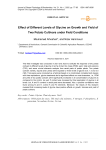
Статья научная
This field investigate was conducted in 2021 and 2023 to evaluate the response of two potato cultivars to different levels of glycine in terms of plant dry mass (PDM), yield, total sold solutions (TSS), and some miniral elements analysis from aerial parts of potato plants. Two potato cultivars namely, Spunta and Larissa were exposed to three levels of glycine (0.0, 1.5 and 3.0 mM). Trial pieces were conducted as a factorial based on a randomized complete block design with three replications. glycine treatments led to signi cant effects on most characters, i.e., PDM and yield of two potato cultivars were significantly increased in all concentrations of glycine as compared to the control. As well, P content was increased by foliar application of glycine in all levels. but, K and Fe content in aerial parts were decreased. Also, a positive correlations were found among N and K, or/and K and Fe elements. Moreover, the results of this research revealed that increasing levels of glycine have positive effects on growth, biomass and yield of potato cultivars.
Бесплатно
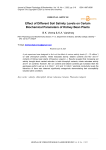
Effect of different soil salinity levels on certain biochemical parameters of kidney bean plants
Статья научная
A pot experiment was designed to find out the effect of various salinity levels (0 - 12 mScm-1) on total chlorophyll contents, nitrate reductase activity, betaine contents and Na+ and K+ contents of Kidney bean plants ( Phaseolus vulgaris L.). Results revealed that increasing soil salinity brought about marked reduction in total chlorophyll contents, nitrate reductase activity and K+ ion contents. However, Na+ ion contents and betaine contents got increased. Both the genotypes perform well up to 4 mScm-1. At 8 and 12 mScm-1 electrical conductivity levels the behaviour of them was observed significantly antagonistic demonstrating their susceptibility towards saline conditions.
Бесплатно
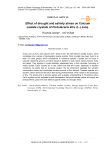
Effect of drought and salinity stress on calcium oxalate crystals of Portulacaria afra. (L.) Jacq
Статья научная
Oxalic acid (C2H2O4) and Calcium (Ca2+) react to form the salt Calcium oxalate (CaOx), which crystallises into a variety of topologically diverse crystals. CaOx crystals have been found in at least 215 plant groups, which corresponds to numerous species. Crystals can be found in vascular, epidermal, ground, and other tissues in addition to roots, stems, leaves, flowers, fruits, and seeds. They develop in crystal idioblasts, specialised cells, in their vacuoles. According to recent studies, CaOx crystals are in fact useful tools that are crucial, especially in stressful conditions. As plants lack an excretory system, the Ca component regulates the cytosolic concentration levels and immobilises excess amounts of this element. Oxalates operate as a dynamic carbon store and set off an alert during photosynthesis, which results in the production of CO2. The article aims to provide readers with a greater understanding of Portulacaria afra's CaOx crystals and the projected crystal disintegration that would liberate carbon and supply the photosynthetic cycles with it as defence against salinity and drought stress.
Бесплатно
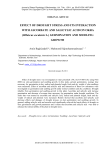
Статья научная
Effect of drought stress was investigated at water potentials of-0.2 &-0.4 MPA (by using PEG 6000) on okra germination and seedling growth. In this study, percent germination, average time necessary for germination in day, radical and plumule length, fresh and dry weight of okra seedlings were measured. Effect of ascorbate and salicylic acid and interaction of these tow substances were investigated on germination and seedling growth under normal condition and dry conditions. Drought inhabits from germination and seedling growth in this plant. Ascorbate and salicylic acid increase germination and decrease of average time necessary for germination under drought conditions. The seeds that were treated by ascorbate and salicylic acid, radical and plumule length, fresh and dry weight of radical and plumule were increased. Results showed that ascorbate and salicylic acid decrease effects and damages of drought stresses on okra germination and seedlings growth. In general, adding salicylic acid and ascorbic acid significantly relieved the harsh effects of drought on okra germination and growth parameters and it seems that ascorbate and salicylic acid were able to enhance the tolerant ability of the plant to drought stress.
Бесплатно
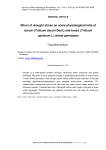
Статья научная
Drought is a wide-spread problem seriously influencing wheat production and quality worldwide. We aimed to study adaptive changes in physiological parameters of 6 durum and 7 bread wheat genotypes under drought stress. Water stress caused reduction of leaf gas exchange parameters-photosynthesis rate, stomatal conductance, intercellular CO 2 concentration, transpiration rate as well leaf area, dry mass, relative water content, and chlorophyll content. Photosynthesis rate, chlorophyll content were higher in flag leaf of bread wheat genotypes. Photosynthesis rate positively correlated with leaf area, dry mass and relative water content.
Бесплатно
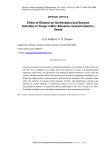
Статья научная
Influence of ethanol the end product of alcoholic fermentation on the growth of finger millet (var. GPU-28, CO-9) seedlings of two finger millet was studied as a means of evaluating growth responses under anoxia. The germination was delayed by ethanol treatment in case of both the cultivars. Ethanol treatment affected the growth of both radicle and coleoptile of seedlings. In this respect the radicle growth is more sensitive to ethanol than the coleoptile in both varieties of finger millet. The activities of enzymes nitrate reductase, ATPase, acid phosphatase, amylase were reduced by alcohol treatment in germinating seeds of both the cultivars. However, lower concentration of alcohol (1%) caused stimulation of peroxidase in var. CO-9. In case of var. GPU-28 showed stimulation of enzyme alkaline phosphatase in both concentration of alcohol.
Бесплатно
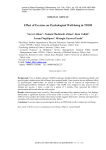
Effect of exercise on psychological well-being in T2DM
Статья научная
Background: Type 2 diabetic patients (T2DM) experience health problems including psychiatric and psychological complications that influence their general health. Since exercise has an additional effect on psychological improvement, we aimed to establish the role of exercise as improvement of psychological problems. Methods: 80 subjects with T2DM were assigned to take exercise for 90 minutes per session, 3 times a week for a period of 4 months. They answered the GHQ-12 questionnaire before and after the study project. Results: Questionnaires were scored by Likert model and entered the statistical analysis. Our findings demonstrate a significant decrease in the mean GHQ-12 scores. [13.39 ± 5.89 to 8.52 ± 5.12 (p
Бесплатно
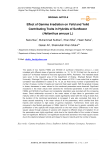
Статья научная
The seeds of two hybrids FSS64 and SF0049 of sunflower ( Helianthus annuus L.) were irradiated with different doses of gamma irradiation i.e., 10, 15, 20, 25 Krad from the source of cobalt Co60 at Nuclear institute for food and agriculture (NIFA), Peshawar. The irradiated seeds were sown in the research area of the department of Botany, Shaheed Benazir Bhutto University, Sheringal, Dir-Upper during the crop season of 2016. It was noted that a negative correlation was established in doses of 10, 15, 20, 25 Krad versus number of parameters like number of leaves, number of seeds per head and fresh seed weight. With the gradual increase in doses, decreases in mean values for the mentioned parameters were observed. Significant reductions in the mean values were observed for mentioned parameters in both the hybrids FSS64 and SF0049 of sunflower and consistently retardation was recorded with the increasing doses. Direct relationship occurred in the mean values of days taken to germination and maturity while on the other hand means values significantly raised with the rising of doses thus the duration of the mentioned parameters is increased...
Бесплатно
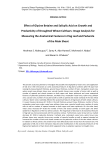
Статья научная
The present study was planned to investigate the possible role displayed by water stress and application of GB, SA or their interaction on some anatomical features in flag leaf at anthesis (after 95 days from sowing) by measuring leaf thickness, ground tissue thickness, number of hairs, metaxylem vessel area, xylem vessel area, phloem tissue area, vascular bundle tissues area, number of motor cells as well as number of opened and closed stomata on both upper and lower epidermis and some anatomical features of peduncle (peduncle diameter, tracheids area, metaxylem vessel area, xylem area, phloem area, vascular area, number of vascular bundle as well as opened and closed stomata) of the two wheat cultivars. Water stress markedly affected the anatomical features in flag leaves of both wheat cultivars. It caused massive decreases (P
Бесплатно
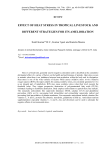
Effect of heat stress in tropical livestock and different strategies for its amelioration
Статья обзорная
Stress is a broad term, generally used in negative connotation and is described as the cumulative detrimental effect of a variety of factors on the health and performance of animals. Heat stress occurs in animals when there is an imbalance between heat production within the body and its dissipation. Heat stress is one of the wide varieties of factors which causes oxidative stress in-vivo. Reactive oxygen species (ROS), the major culprits for causing oxidative stress, are constantly generated in vivo as an integral part of metabolism. ROS may cause oxidative stress when their level exceeds the threshold value. They trigger progressive destruction of polyunsaturated fatty acids (PUFA), ultimately leading to membrane destruction. Body employs antioxidants to quench these free radicals. The enzymatic antioxidants like superoxide dismutase (SOD), catalase (CAT) and glutathione peroxidase (GPx) act by scavenging both intracellular and extracellular superoxide radical and preventing lipid peroxidation of plasma membrane. Non-enzymatic antioxidants include vitamins like vitamins C, A and E, proteins like albumin, transferrin, glutathione (GSH) etc. Antioxidant nutrient supplementation especially vitamins C, A and E, zinc and chromium can be used to attenuate the negative effects of environmental stress.
Бесплатно
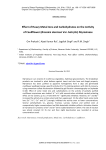
Статья научная
Myrosinase is an enzyme of cruciferous vegetables, hydrolyse glucosinolates. The breakdown products are involved in plant defence against insect and also have anti-fungal property. Myrosinase has been purified to apparent homogeneity from 5 days old germinated cauliflower seedlings having a specific activity of 12.71 units/mg proteins with 54.6 % recovery, using ammonium sulfate fractionation followed by gel filtration chromatography on Sephadex G-100. Effect of some metal ions and carbohydrates on the activity of partially purified cauliflower myrosinase was studied. Sr +2 at 4 mM concentration exhibited marked activating effect on the activity up to 2.7 fold while Fe +2 significantly inhibited. However, Sn +2 and Ba +2 increased the activity to a certain extent and then suppressed. On the other hand, some metal ions [Fe +2, Fe +3, Cu +2 and Zn +2] strongly inhibited the activity even at lower concentrations. Several carbohydrates viz., glucose, fructose, sucrose, maltose and sorbitol even at comparatively higher concentrations had little detectable inhibitory effects. Activation kinetics of myrosinase in presence of Sn +2 and Sr +2 were studied between 0- 20min. The rate of reaction was almost constant till 15 min and then slight deactivation was recorded at various concentrations used.
Бесплатно
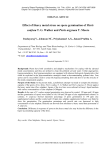
Статья научная
Background: Plants have both and adaptive mechanisms for coping with the elevated metal concentrations and they are utilized to clean the polluted soil and water. Unlike angiosperms hyperaccumulators, fern hyperaccumulators are equipped with inherent biological characteristics that could be exploited in the phytoremediation strategies aimed at decontaminating polluted sites. spores can be successfully used to screen the hyperaccumualting ferns and also to test the toxicity of the metal contaminated samples. Purpose of the Study: In the present study, a preliminary attempt was made to compare the tolerance capacity of the spores of two ferns; Pteris confusa T. G. Walker and Pteris argyraea T. Moore against the heavy metal zinc (Zinc sulphate). Spores of the two ferns were cultured in Knop's liquid medium with various concentrations of zinc sulphate (0-200ppm). Results: In the case of P. confusa normal germination was observed in control, 120 ppm and 140 ppm and the germination of spores were failed in 160, 180 and 200 ppm of zinc supplemented cultures. In contrary, P. argyraea showed maximum percentage of spore germination in 140 ppm zinc supplemented cultures and the control and 120 ppm zinc sulphate supplemented cultures were failed to show the germination. The germination percentage and growth rate was decreased in high concentration of zinc sulphate. are showed more tolerance to heavy metal than protonema of P. argyraea. Conclusion: Difference in response of spores to the heavy metal zinc may be due the difference in the hyper-accumulating capacity of the ferns.
Бесплатно
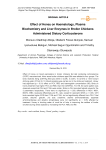
Статья научная
Effect of honey on blood parameters in broiler chickens fed diet containing corticosterone (CORT) was examined. Arbor acres broiler chickens aged 28d were allotted to four groups. The birds received 30mg CORT/kg feed plus either 0 (C0H), 5 (C5H), 10 (C10H) or 15ml honey/l drinking water (C15H) for 7d. Blood sampling was carried out in five birds per treatment. Honey had significant (p 0.05) differences in MCV, MCH, MCHC, WBC, leukocyte differentials and H:L ratio, except for oesinophil (EOS; p 0.05) affected by treatment. Honey in drinking water of could be of help in improving the welfare of broiler chickens during stress episode by increasing the PCV, RBC and HB.
Бесплатно

